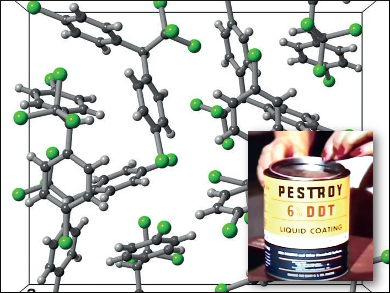Michael D. Ward, New York University, USA, Bart Kahr, New York University and Waseda University, Tokyo, Japan, and colleagues have found a new polymorph of the insecticide DDT (1,1,1-trichloro-2,2-bis(4-chlorophenyl)ethane [1] and discussed false claims about DDT’s effectiveness [2].
DDT became widely used in applications from delousing soldiers to killing mosquitos following the report of its insecticide properties in 1944. DDT is used in solid-state formulations and is absorbed through the footpads of insects in contact with the DDT crystals.
The researchers set out to investigate how DDT behaves in the solid state, as its crystals show helicoidal twisting, that is, the molecular crystals twist around the growth direction. The scientists isolated a second polymorph of DDT as single crystals. This polymorph (Form II, pictured) was found to be more toxic to insects than the previously reported form (Form I). This can be explained by the varying activities of the different crystal faces and the fact that crystals with smaller lattice energies are more effectively solubilized by fluids secreted by insects’ feet. This means that lower-dose formulations of DDT in Form II can be as effective as standard formulations, but will exert lower environmental impact because less DDT is required for the same effect.
DDT’s heyday ended when it was banned in 1972 because of its effects on healthy ecosystems, which were raised by Rachel Carson in her book Silent Spring (1962) [3]. Carson’s claims, which have been confirmed repeatedly, were neither appreciated by the chemical industry nor by certain interest groups who believed that millions of deaths of malaria could be blamed on just one scientist. The argument that environmental regulation has unintended consequences is also used by climate-change deniers. Furthermore, Carson was reported to have misused or even fabricated data; however, the team shows that only selective facts were given by her opponents.
The researchers conclude by emphasizing how scientists have lost the power to convince society about their evidence-based claims, and how opponents of science are not restricted by the evidence that is presented to them. Public trust in scientists is not what it used to be, with the effect that those who have all the evidence are simply defamed. And the truth about DDT? It failed because insects became resistant to it. Not because of Rachel Carson.
References
- [1] DDT Polymorphism and the Lethality of Crystal Forms,
Jingxiang Yang, C. T. Hu, Xiaolong Zhu, Qiang Zhu, Michael D. Ward, Bart Kahr,
Angew. Chem. Int. Ed. 2017.
DOI: 10.1002/anie.201703028 - [2] Abuse of Rachel Carson and Misuse of DDT Science in the Service of Environmental Deregulation,
Jingxiang Yang, Michael D. Ward, Bart Kahr,
Angew. Chem. Int. Ed. 2017.
DOI: 10.1002/anie.201704077 - [3] Silent Spring,
Rachel Carson,
Houghton Mifflin, 1962.
ISBN: 9780395075067




